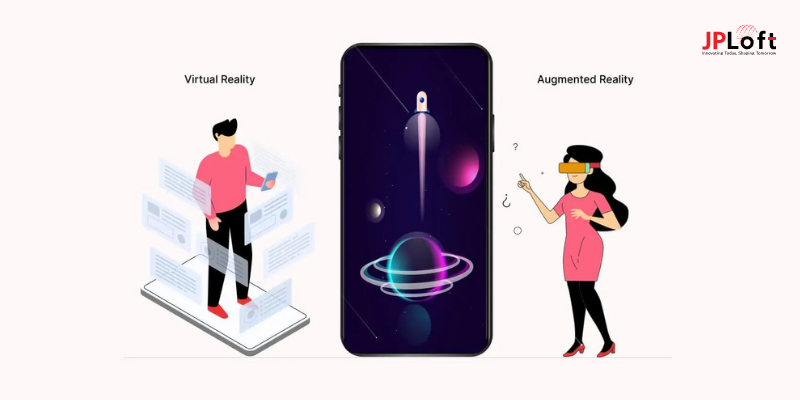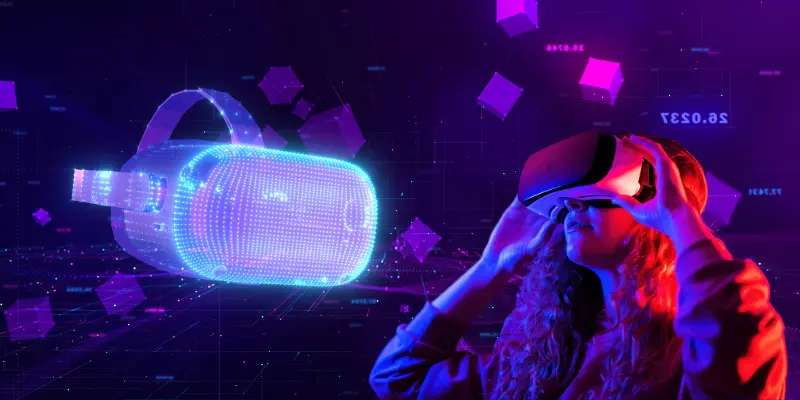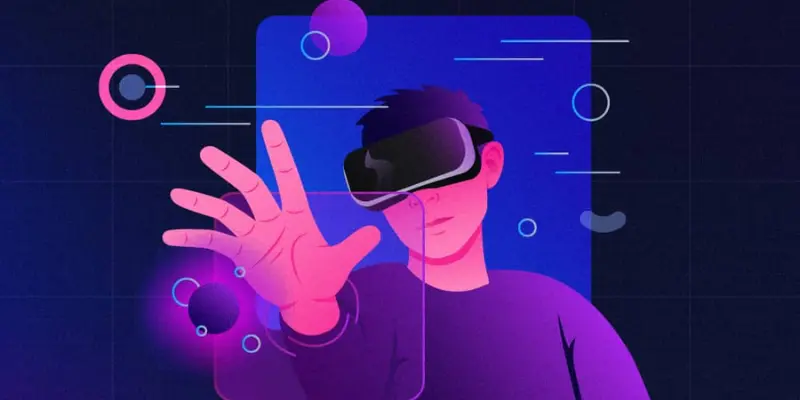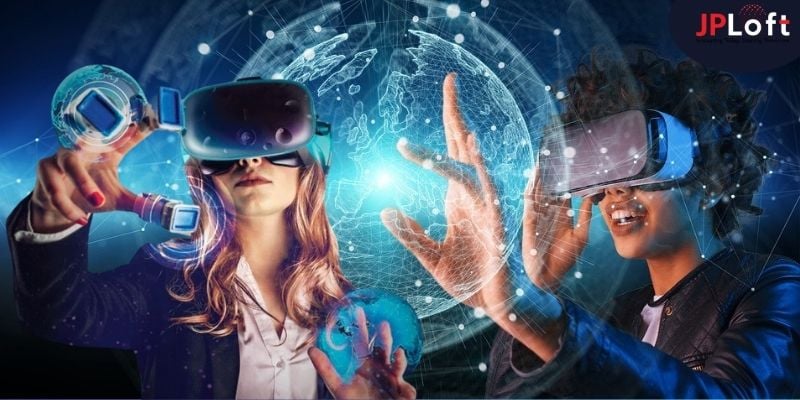Augmented and Virtual Reality App Development has quickly emerged as transformative forces within technology's ever-evolving environment, altering how we engage with digital content and perceive our environment.
Mobile application developers continue pushing innovation boundaries forward while Augmented/Virtual Reality Development plays an essential role in improving user experiences while opening up new vistas within various industries.
AR and VR App Development extends beyond entertainment, permeating education, healthcare, gaming, and enterprise solutions. These immersive technologies link physical and digital realms, allowing unprecedented engagement opportunities while solving real problems effectively.
Mobile app development companies play a pivotal role in harnessing the full potential of AR and VR, creating applications that not only meet but surpass user expectations but push technological barriers further.
As AR and VR technologies advance, demand for customized apps continues to soar. Mobile app development companies have taken note, capitalizing on consumers' increasing desire for immersive experiences through immersive apps that cater to consumer desires and provide businesses with solutions designed to streamline operations and foster communication.
The Role of AR and VR App Development in Tech Evolution
Role of AR and VR app development on technological progress:
Enhancing user experiences
AR and VR app development is invaluable in elevating user experiences across diverse domains. AR applies digital information directly onto natural world objects in real-time to provide users with context-relevant data in real-time - for instance, Pokemon Go demonstrated this. Furthermore, applications like it use AR technology to gamify experiences while engaging users in novel ways.
VR immerses users into virtual environments for an engaging and immersive experience, providing immersive virtual environments for gaming, entertainment, and healthcare applications. Both technologies represent innovative ways for users to interact with digital content - which could revolutionize how we consume it!
Revolutionizing Education
AR and VR have had an extraordinary effect on training and education. VR's immersive simulations recreate realistic scenes for immersive training environments - providing safe yet secure conditions where professionals can practice complex procedures without real-life consequences.
Their effectiveness has become apparent in industries such as aviation and healthcare, where professionals practice complex techniques without real-world effects being felt directly by patients or professionals involved.
AR supplements real-world experiences with digital information to amplify learning processes, making education more engaging, interactive, and practical while changing traditional teaching methodologies. Educational apps incorporating AR/VR technologies make learning even more enjoyable while revolutionizing conventional teaching methodologies.
Empowering Industries Through Visualization
AR and VR app development is revolutionizing industries by revolutionizing data visualization. AR allows professionals in fields like architecture and design to overlay digital models onto physical spaces in real-time for viewing arrangements as they unfold; similarly, VR prototypes enable engineers to interact with products before being physically created.
This not only speeds up the design process but also lowers costs and increases the quality of the final product. Visualizing complex data in immersive environments enhances decision-making across industries.
Change in Healthcare
The healthcare industry is seeing significant change through AR and VR app development. VR therapy apps offer patients immersive environments to aid recovery.
Virtual reality simulations allow surgeons to hone their craft safely, while AR facilitates surgical planning by offering real-time data overlays during surgery. Both technologies contribute to enhanced patient outcomes, reduced healthcare costs, and improved medical training - representing an exciting era of healthcare advancements.
Revolutionizing Marketing and Retail
AR/VR technologies are revolutionizing how companies market and retail their products to customers, engaging them more deeply through immersive AR experiences that allow shoppers to see how products look in real life before purchasing online, elevating customers' shopping experiences.
VR takes this a step further by offering virtual stores where users can explore products in a realistic environment, creating immersive experiences that increase customer engagement and influence purchasing decisions. Through AR and VR app development in the marketing and retail sectors, AR/VR app development creates more engaging shopping experiences with more personalized touches for shoppers.
AR and VR Are Fostering Social Interaction
AR and VR technology offer much more than just a solitary experience; they allow people to connect in new ways. Virtual Reality social platforms enable users to secure virtually and overcome physical distance.
AR applications enhance real-life social interactions by providing contextual data about those and places around us. As this technology evolves further, its potential may radically reshape how we collaborate and communicate across boundaries while breaking down barriers between us and opening new channels for interaction among humans.
Arguing With Technical Limits
AR and VR app development offers immense promise; however, its development comes with obstacles. Technical restrictions, security risks, and widespread adoption impede seamless incorporation into everyday life.
However, these challenges also present opportunities for innovation and advancement. As technology develops, overcoming these hurdles will become more essential in unlocking AR/VR app development's full potential.
Steps to Build an AR and VR App
Essential steps to build an AR and VR App successfully:
Outline Objectives and Target Audience
To start successfully creating your AR and VR app, clearly establish its objectives by outlining any problems it seeks to solve or experiences it hopes to offer its target audience. This understanding also determines design decisions as it impacts functionality and user experience - whether your app is intended for gaming, education, healthcare, or another industry, this step is integral for successful app creation.
Conduct Market Research
To be competitive in AR/VR app development, conducting detailed market research to identify existing AR and VR apps in your niche is vitally important. By studying their strengths and weaknesses, user reviews, and market trends, this analysis can help refine app concepts while pinpointing unique selling points to ensure it stands out in today's highly competitive landscape.
Select the Appropriate Platforms and Development Tools
Deciding upon an ideal platform and development tools is crucial when developing AR and VR apps. For mobile platforms (iOS and Android),AR applications target mobile users, while VR apps target platforms like Oculus Rift, HTC Vive, or PlayStation VR as platforms of interest. Furthermore, select development engines compatible with your desired platform, like Unity or Unreal Engine, that offer solid foundations for creating immersive experiences.
Create an Intuitive Interface
User experience is paramount for AR and VR developers, so creating an intuitive and user-friendly interface should enhance the overall user experience. Consider factors like navigation, interactions, and visual aesthetics - significantly, since AR/VR alters traditional screen-based interfaces, testing designs to achieve seamless and comfortable experiences is vitally essential in AR and VR development.
Create Engaging Content
Content creation is at the heart of a successful AR and VR app, from 3D models, animations, or interactive elements - whatever may fit best within its objectives and user journey. Leverage the capabilities of AR/VR technologies for an unforgettable user experience!
Implement Tracking and Recognition
AR apps rely heavily on tracking and recognition technologies to overlay digital content over physical environments, so including features like marker-based tracking or object recognition is often crucial for improving the functionality of such apps. VR headsets typically utilize head tracking or motion sensing technologies for more immersive virtual world experiences.
Optimize for Performance
Optimizing AR and VR apps to provide users with a lag-free experience is of utmost importance for providing users with an immersive and seamless experience. Please closely consider factors like frame rate, rendering quality, load times, and framerate as you optimize it to your target platform for the best performance results.
Integrate AR and VR Hardware
Hardware integration is an integral component to fully realizing AR and VR apps. AR apps should ensure compatibility with either Apple ARKit for iOS devices or Google ARCore for Android operating systems; for VR headsets, hand controllers or haptic feedback features should also be integrated for optimal experience and increased immersion.
These considerations ensure optimal results from hardware augmentation efforts that make your apps genuinely immersive for their users.
Conduct Thorough Tests
Proper testing is critical to discovering and fixing AR and VR apps' bugs, glitches, and performance issues. Make sure that they run across a range of devices to test compatibility across platforms and conduct user trials to gather feedback on its usability - these steps will ultimately enhance user experiences overall.
Gather Feedback and Iterate
After your app's initial release, actively solicit user reviews for insights into areas for improvement and implement updates accordingly. An iterative development approach such as this helps stay ahead of the game as users' needs shift constantly - helping your app maintain top performance at every point along its lifecycle.
Future Trends of AR and VR
The AR and VR landscape is set for dramatic transformation with recent innovations and emerging AR VR Trends that promise to revolutionize it.
Integration of AR and VR
One trend shaping the future of AR and VR is their increasing integration. Once seen as distinct entities, these technologies converge to form seamless mixed-reality user experiences.
Convergence between real and virtual worlds has long been sought as companies seek ways to bridge them seamlessly. Many organizations are exploring methods for adding AR elements into VR environments for users' immersive experience and vice versa, creating more varied, complex immersive experiences for them.
Spatial Computing
Spatial computing has emerged as an essential concept within AR/VR technologies. It emphasizes analyzing space within physical and virtual environments to enhance users' experiences through more realistic, context-aware experiences. With advances in spatial computing technology, users may expect even better visual experiences!
Spatial computing lays the groundwork for more intuitive and engaging user experiences where digital content seamlessly blends in with Reality. This new technology offers many potential uses: improved object recognition, gesture controls, and better integration between physical environments and digital content.
5G Connectivity and Edge Computing
5G networks will transform AR/VR experiences. Their high speed/low latency features will enable smoother interactions, with reduced latency lag time that increases immersion overall.
5G and edge computing will also empower AR/VR devices to offload processing tasks to the cloud, opening up possibilities for rendering complex graphics in real-time simulations. This shift towards faster, more reliable connectivity could prove game-changing in AR and VR.
Extended Reality (XR)
Extended Reality is an umbrella term covering AR, VR, and other immersive technologies. As AR and VR evolve towards becoming one integrated XR ecosystem, users can quickly transition between them as per their preferences - seamlessly transitioning between them depending on needs or preferences.
XR blurs the boundaries between physical and virtual realities, offering experiences beyond what individual AR or VR applications provide. We can expect it to create an increasingly coherent immersive landscape as it matures.
Immersive Healthcare Solutions
Healthcare sectors have increasingly used AR and VR technologies in patient care, medical training, and therapy settings. Future trends for AR/VR in healthcare will likely include more sophisticated applications.
Surgeons can use AR overlays during procedures for real-time guidance, while VR simulations enable medical professionals to practice complex systems risk-free. Furthermore, AR and VR have proven powerful tools in mental health treatment, with immersive therapy sessions and anxiety relief applications available through various apps.
AR and VR in Education
AR and VR have quickly become part of education as they offer immense potential to transform traditional learning experiences by making them more interactive and immersive for students. VR provides them first hand exposure to historical events or scientific phenomena for an unforgettable learning experience.
Conversely, AR enhances real-world learning by superimposing digital data onto physical objects in real space. We should expect increased adoption of both AR and VR within educational institutions in the coming years to create new forms of experiential learning experiences for their students.
Social VR Experiences
AR and VR technologies promise more than individual experiences; there's also an expanding focus on social interactions within virtual spaces. Social VR platforms have evolved considerably to facilitate more meaningful connections among users within immersive virtual realities.
Integrating social elements into business meetings, social gatherings, or virtual events enhances a sense of presence and connectivity within virtual spaces. Social VR experiences may revolutionize how we collaborate and communicate within digital settings.
Conclusion
The rapid development of technology has led to a paradigm shift. AR and VR apps have played a pivotal role in this. Augmented Reality and Virtual Reality applications have revolutionized how we interact with digital content and physical environments.
AR VR app development services have an immense effect on shaping the future of technology. From immersive gaming experiences to revolutionizing industries like healthcare, education, and business - AR/VR apps reinvent user engagement and experience in ways never thought possible!
Integrating these technologies has opened the door for groundbreaking possibilities that increase productivity and efficiency across numerous sectors.
Businesses and industries have rapidly recognized the power of AR and VR, prompting a dramatic spike in demand for dedicated app development services for AR/VR apps. Companies now utilize developers with cutting-edge skills to create advanced applications that meet various user needs - services that foster innovation and connect physically with digital realities.
FAQs
1. What Is the Importance of AR and VR App Development?
AR and VR app development is essential in creating immersive digital experiences by seamlessly merging real-world and virtual-world elements.
2. How Can AR and VR App Development Increase User Engagement?
AR/VR Application Development provides interactive experiences and more immersive digital media. Users enjoy this more captivating digital interaction.
3. What Industries Benefit Most from AR and VR App Development?
Numerous industries -- gaming, education, healthcare, and real estate -- rely heavily on AR/VR apps in their day-to-day work for training purposes, customer engagement purposes, or visualization purposes.
4. How has AR and VR Technology Changed Training and Education?
AR/VR App Development revolutionizes education by creating realistic simulations that allow users to practice what they learn within virtual environments, significantly increasing retention and skill acquisition rates.
5. What challenges exist with AR and VR App Development?
AR/VR app developers face numerous hurdles during app creation, such as hardware compatibility issues, too expensive development costs, and user experience concerns being met in full while advancements seek to address them all. However, ongoing progress continues, addressing such obstacles to progress.
6. Are AR and VR apps only intended for entertainment purposes?
No. AR/VR App Development's role goes beyond mere amusement; such technologies have applications across industries, including healthcare simulations, training systems development in manufacturing plants, and virtual real estate tours.
7. How can businesses leverage AR and VR apps into their strategies?
Businesses gain a competitive advantage by using AR/VR applications for marketing, customer engagement, and product visualization - ultimately increasing brand perception and satisfaction levels among their target demographic.
8. Are AR and VR apps only limited to high-end devices?
While initially associated with expensive computers, the Role of AR/VR App Development has now evolved to encompass mobile device apps, making these technologies accessible and usable by more people than ever before.
9. Are augmented and virtual reality applications critical in marketing and advertising?
AR and VR applications play an increasingly vital role in modern marketing by providing interactive experiences for their target audiences - unique brand engagement opportunities at an unprecedented scale.
10. How Does AR and VR App Development Contribute to Innovation in Business Processes?
AR/VR apps drive innovation by streamlining workflows, improving communication channels, and increasing collaboration within various industries - creating a more productive work environment and encouraging efficiency at work.










